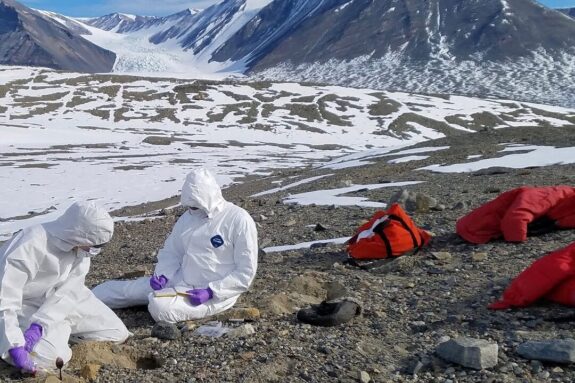Study: Rocks from Mars’ Jezero Crater, which likely predate life on Earth, contain signs of water

NASA’s Perseverance rover puts its robotic arm to work around a rocky outcrop called “Skinner Ridge” in Mars’ Jezero Crater. Composed of multiple images, this mosaic shows layered sedimentary rocks in the face of a cliff in the delta, as well as one of the locations where the rover abraded a circular patch to analyze a rock’s composition. Image credit: NASA/JPL-Caltech/ASU/MSSS
In a new study appearing today in the journal AGU Advances, scientists at MIT and NASA report that seven rock samples collected along the “fan front” of Mars’ Jezero Crater contain minerals that are typically formed in water. The findings suggest that the rocks were originally deposited by water, or may have formed in the presence of water.
The seven samples were collected by NASA’s Perseverance rover in 2022 during its exploration of the crater’s western slope, where some rocks were hypothesized to have formed in what is now a dried-up ancient lake. Members of the Perseverance science team, including MIT scientists, have studied the rover’s images and chemical analyses of the samples, and confirmed that the rocks indeed contain signs of water, and that the crater was likely once a watery, habitable environment.
Whether the crater was actually inhabited is yet unknown. The team found that the presence of organic matter — the starting material for life — cannot be confirmed, at least based on the rover’s measurements. But judging from the rocks’ mineral content, scientists believe the samples are their best chance of finding signs of ancient Martian life once the rocks are returned to Earth for more detailed analysis.
“These rocks confirm the presence, at least temporarily, of habitable environments on Mars,” says the study’s lead author, Tanja Bosak, professor of geobiology in MIT’s Department of Earth, Atmospheric and Planetary Sciences (EAPS). “What we’ve found is that indeed there was a lot of water activity. For how long, we don’t know, but certainly for long enough to create these big sedimentary deposits.”
What’s more, some of the collected samples may have originally been deposited in the ancient lake more than 3.5 billion years ago — before even the first signs of life on Earth.
“These are the oldest rocks that may have been deposited by water, that we’ve ever laid hands or rover arms on,” says co-author Benjamin Weiss, the Robert R. Shrock Professor of Earth and Planetary Sciences at MIT. “That’s exciting, because it means these are the most promising rocks that may have preserved fossils, and signatures of life.”
The study’s MIT co-authors include postdoc Eva Scheller, and research scientist Elias Mansbach, along with members of the Perseverance science team.
At the front
The new rock samples were collected in 2022 as part of the rover’s Fan Front Campaign — an exploratory phase during which Perseverance traversed Jezero Crater’s western slope, where a fan-like region contains sedimentary, layered rocks. Scientists suspect that this “fan front” is an ancient delta that was created by sediment that flowed with a river and settled into a now bone-dry lakebed. If life existed on Mars, scientists believe that it could be preserved in the layers of sediment along the fan front.
In the end, Perseverance collected seven samples from various locations along the fan front. The rover obtained each sample by drilling into the Martian bedrock and extracting a pencil-sized core, which it then sealed in a tube to one day be retrieved and returned to Earth for detailed analysis.
Prior to extracting the cores, the rover took images of the surrounding sediments at each of the seven locations. The science team then processed the imaging data to estimate a sediment’s average grain size and mineral composition. This analysis showed that all seven collected samples likely contain signs of water, suggesting that they were initially deposited by water.
Specifically, Bosak and her colleagues found evidence of certain minerals in the sediments that are known to precipitate out of water.
“We found lots of minerals like carbonates, which are what make reefs on Earth,” Bosak says. “And it’s really an ideal material that can preserve fossils of microbial life.”
Interestingly, the researchers also identified sulfates in some samples that were collected at the base of the fan front. Sulfates are minerals that form in very salty water — another sign that water was present in the crater at one time — though very salty water, Bosak notes, “is not necessarily the best thing for life.” If the entire crater was once filled with very salty water, then it would be difficult for any form of life to thrive. But if only the bottom of the lake were briny, that could be an advantage, at least for preserving any signs of life that may have lived further up, in less salty layers, that eventually died and drifted down to the bottom.
“However salty it was, if there were any organics present, it’s like pickling something in salt,” Bosak says. “If there was life that fell into the salty layer, it would be very well-preserved.”
Fuzzy fingerprints
But the team emphasizes that organic matter has not been confidently detected by the rover’s instruments. Organic matter can be signs of life, but can also be produced by certain geological processes that have nothing to do with living matter. Perseverance’s predecessor, the Curiosity rover, had detected organic matter throughout Mars’ Gale Crater, which scientists suspect may have come from asteroids that made impact with Mars in the past.
And in a previous campaign, Perseverance detected what appeared to be organic molecules at multiple locations along Jezero Crater’s floor. These observations were taken by the rover’s Scanning Habitable Environments with Raman and Luminescence for Organics and Chemicals (SHERLOC) instrument, which uses ultraviolet light to scan the Martian surface. If organics are present, they can glow, similar to material under a blacklight. The wavelengths at which the material glows act as a sort of fingerprint for the kind of organic molecules that are present.
In Perseverance’s previous exploration of the crater floor, SHERLOC appeared to pick up signs of organic molecules throughout the region, and later, at some locations along the fan front. But a careful analysis, led by MIT’s Eva Scheller, has found that while the particular wavelengths observed could be signs of organic matter, they could just as well be signatures of substances that have nothing to do with organic matter.
“It turns out that cerium metals incorporated in minerals actually produce very similar signals as the organic matter,” Scheller says. “When investigated, the potential organic signals were strongly correlated with phosphate minerals, which always contain some cerium.”
Scheller’s work shows that the rover’s measurements cannot be interpreted definitively as organic matter.
“This is not bad news,” Bosak says. “It just tells us there is not very abundant organic matter. It’s still possible that it’s there. It’s just below the rover’s detection limit.”
When the collected samples are finally sent back to Earth, Bosak says laboratory instruments will have more than enough sensitivity to detect any organic matter that might lie within.
“On Earth, once we have microscopes with nanometer-scale resolution, and various types of instruments that we cannot staff on one rover, then we can actually attempt to look for life,” she says.
This work was supported, in part, by NASA.


